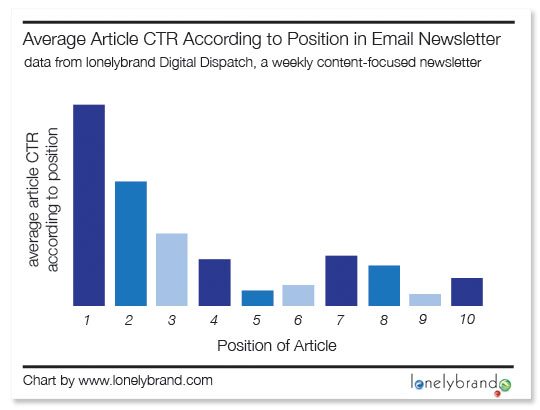A few weeks back we were asked how “burying the lead” in email newsletters — that is, placing the piece of content that is referenced in the subject line further into the email — affects click through rate. We prowled the Web for relevant researuch but came up empty handed and thus set out to find the answers ourselves.
Hypothesis
Our hypothesis became: when the lead is buried in an email, openers are more likely to be intrigued by — and click — other content within the email.
Methodology
To test this idea, we poured over several months’ worth of data from the Digital Dispatch, lonelybrand’s weekly content roundup newsletter, which contains the 10 blog posts from the previous week. Since Digital Dispatch articles are different in each weekly email and some articles are naturally more compelling than others, this is by no means a true A/B test. But the sample does bring up a few interesting points on how subscribers interact with a content-based newsletter, and how the ordering of content affects that interaction.
The diagram below shows what we mean by “article position” — the first article is in position one, then two, three and so on, with each email containing 10 articles total. “Burying the lead” refers to any email where the subject line refers to an article not contained in position one. For example, in the email below if the subject line referred to the implications of Google Reader’s retirement (article three) we would say that the lead is buried.
Results
Burying the lead boosts unique clicks per open
First off, we looked at how burying the lead affects unique clicks per open — in other words, of those who opened, how many people actually clicked through to an article? And how did this number change as we moved the subject line-referenced article from position one to two to three?
The data shows that as we move the subject-referenced article down, more people actually clicked some article within the email. When that article was in position one, 15.9% clicked something. When in position two, 17.2% clicked, and in position three, 22.2% clicked an article.
The earlier the subject line-referenced article appears, the more people click it
Our assumption was that by placing the article referenced in the subject line first, people would see it sooner without getting distracted and thus be more likely to click on that particular article.
Not surprisingly, this turned out to be true. When the subject-referenced article was in position one, the CTR for that particular article turned out to be nearly 50%. And the further we buried the lead, the lower the CTR dropped for that article.
More people click on other content when the lead is buried
Next up we wanted to find out if burying the lead increased the chances that subscribers would click through to other articles not mentioned in the subject line. The hope was that by pulling subscribers’ eyes through the email to find the article referenced in the subject, other intriguing content would catch their eye and inspire them to click.
According to the data, this seems to be true. The further we buried the lead, the more likely subscribers were to click on other content. When the subject line-referenced article was in position one, 52.8% clicked on other content. Another 66.7% clicked on other content when the lead was in position two, and 78.9% when in position three.
Regardless of subject line, the first three articles always get more clicks
Taking subject line out of the equation, our data shows that articles one, two and three by far get the most clicks — but that doesn’t mean that subscribers aren’t scrolling through the rest of the content. In fact, article ten all the way at the bottom gets a substantial share of clicks.

So, what does this mean for your brand’s email newsletters? Obviously, if your primary goal is to get subscribers to click one piece of content, mention that in the subject and position it first and foremost within the email. But if you’re looking to engage a wider audience with various content rather than one specific piece, go ahead and test out content positioning within the email. Last but not least, never assume that the first couple of points in your newsletter are the only ones that get attention or clicks.




